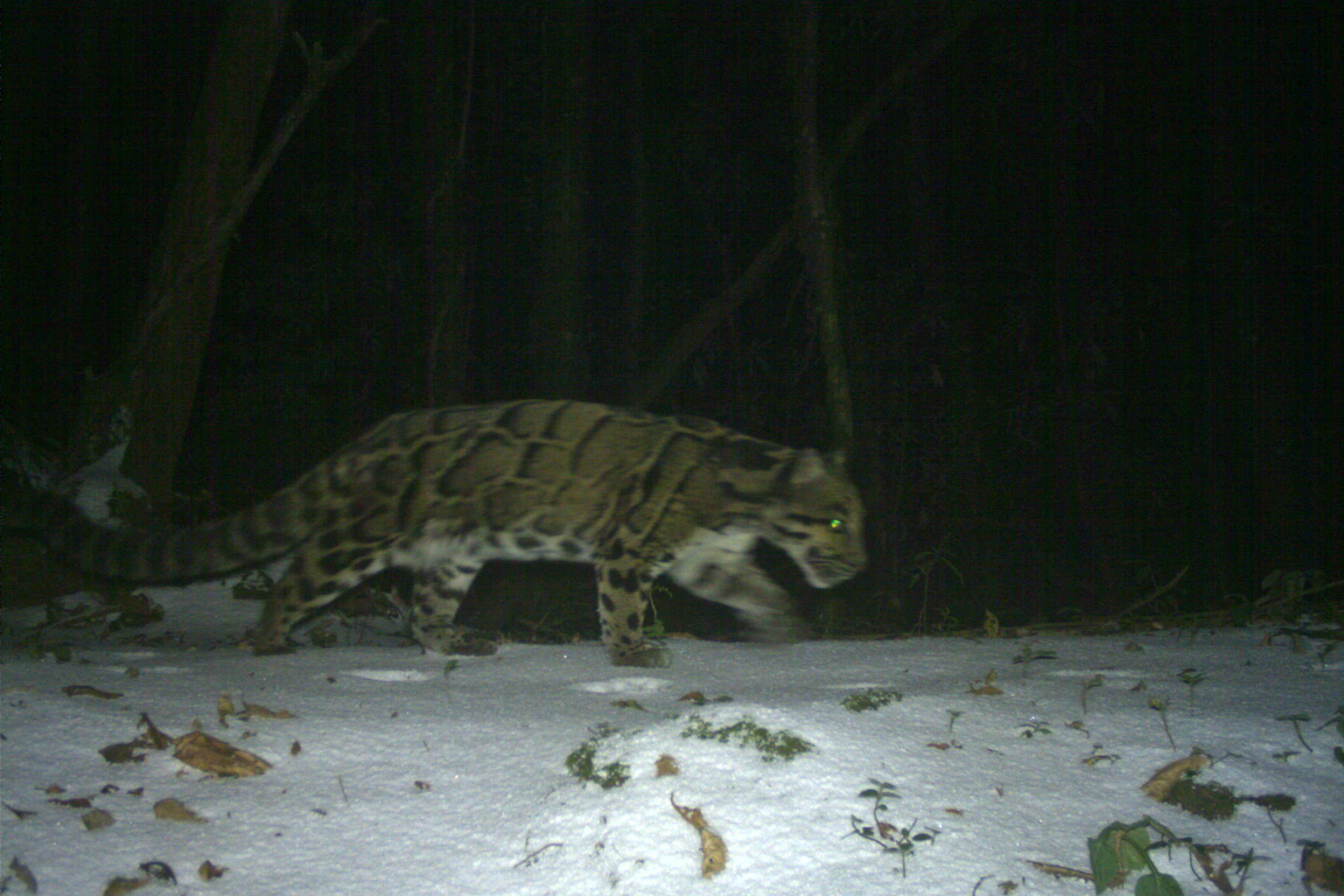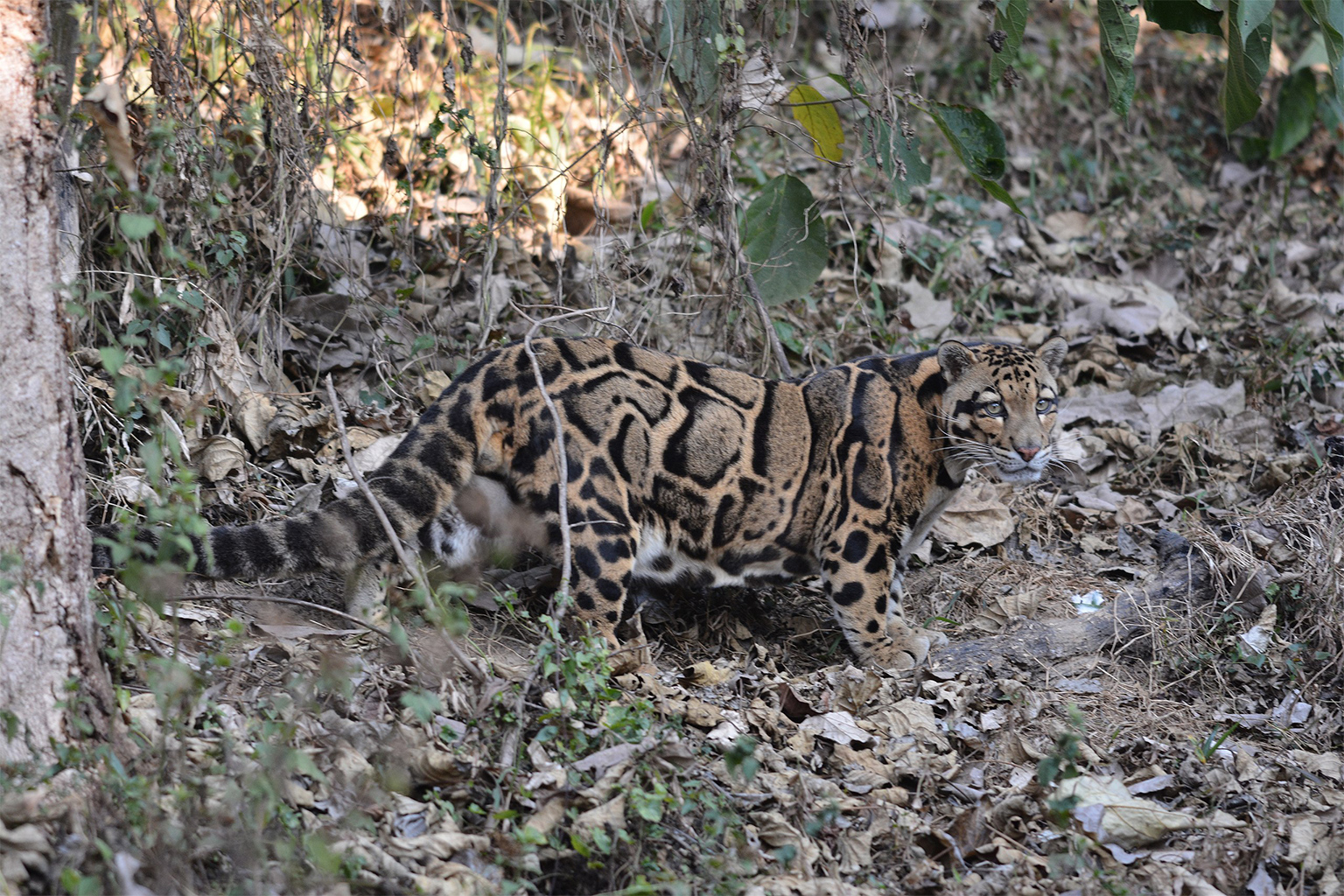- Yadav Ghimirey, one of the pioneering clouded leopard researchers in Nepal, shares his challenges and achievements of conducting camera trap surveys, scat analysis and pelt identification of the elusive clouded leopards in different regions of Nepal, where they are very rare and poorly understood.
- He argues that clouded leopards are important for Nepal’s biodiversity and ecosystem balance and that they deserve more attention and funding from local and global conservation agencies.
- He outlines his need to assess the distribution, diet, behavior and habitat connectivity of clouded leopards in Nepal and to work on their conservation.
The clouded leopard (Neofelis nebulosa) is one of the most elusive cat species found in Nepal, with a conservation status categorized as vulnerable. The cat, called dhwase chituwa in Nepali (which translates to smoky leopard) for its unique pelt has been recorded in different regions of Asia ranging from the Himalaya foothills in Nepal through mainland Southeast Asia into China.
Nepal (the Chitwan-Annapurna Landscape in particular) is considered the westernmost fringe habitat of the animal, which was recorded by camera trap for the first time in 2010, in Shivapuri Nagarjun National Park in the Kathmandu Valley. It was subsequently reported farther east in Langtang, Makalu–Barun, Kanchenjunga and Chitwan-Annapurna.
Not only is the cat rare, researchers focusing on the felid species are also hard to find in the country. Yadav Ghimirey, who is pursuing his Ph.D. at the University of Florida, is one of the pioneering researchers studying clouded leopards in the country. Mongabay’s Abhaya Raj Joshi talked to Ghimirey over a video call recently about the state of clouded leopard research in Nepal, its challenges and future prospects. The following interview has been translated from Nepali and edited for clarity.

Mongabay: How did you develop interest in clouded leopards?
Yadav Ghimirey: I don’t exactly remember. Many animals are named as “common”; for example, common leopard and common pigeon. But the clouded leopard has a “cloud” in its name that makes it unique and struck a chord with me for some reason. I also learned later that it is understudied not only in Nepal, but also in the whole world and that we don’t have an estimate of its global population.
Mongabay: When you decided that you wanted to do research on clouded leopards, how did you go about managing the funds?
Yadav Ghimirey: It was back in around 2007-08 that I actively started looking for funding for my research. There’s a basket fund called CEPF (the Critical Ecosystem Partnership Fund) that was looking to work in the eastern Himalayas through WWF. When I approached them with my proposal to study clouded leopards, they suggested that instead of just focusing on clouded leopards, which are rare, we focus on small carnivores in the Makalu Barun National Park area. We accepted their suggestion, as we were also not sure whether we’d find any clouded leopards in our camera traps. We conducted our camera trapping work in 2009.
Mongabay: What were some of the challenges you encountered during your fieldwork?
One of the main challenges was that camera traps those days had a lag of around 1-1.5 seconds after an animal triggered its shutter. This meant that we had to set up the camera traps in such a way that the animal comes into the frame of the camera 1-1.5 seconds after it triggers the shutter. Setting up camera traps in the hills wasn’t easy.
Mongabay: Did you manage to photograph any clouded leopards?
Yadav Ghimirey: Unfortunately, none of the 21 camera traps we used could detect clouded leopards. However, we did manage to find two pelts that were with the local people and identified them as belonging to clouded leopards.
In hindsight, I can say that if I get the same opportunity again, I can definitely photograph a handful of clouded leopards. But in those days, we didn’t have the required skills and knowledge to do that.
In the following years, we carried out camera trap surveys in the Annapurna region as well as in Chitwan. But the only time we photographed clouded leopards was in 2017 when we obtained eight photos of four individuals.

Mongabay: In your opinion, what has the research on clouded leopards in Nepal contributed to the global body of knowledge on clouded leopards?
That’s a difficult question to answer, as clouded leopards are so rare in Nepal. All we know is that they live in the forest and the Annapurna region could be their western-most habitat. But a pelt has been seized by police farther west, suggesting they might be distributed farther west than previously believed.
Similarly, it was found in eastern Nepal in a village surrounded by a fragmented forest. This was something unexpected.
Mongabay: Have you carried out scat surveys to find out where the cats live?
That, too, is not easy. We know that clouded leopards are around the size of an average dog. This means that their scat is a bit bigger than the leopard cat or the jungle cat and smaller than the leopard or tiger.
But we are currently working on a project to collect suspected clouded leopard scats and to look at their DNA makeup so that we know which scats are likely to be of clouded leopards.
Also, because we don’t know for sure what its scat looks like, we don’t know what it eats.
Mongabay: In Nepal’s hills, leopards are being persecuted in various places as they interact with people and their livestock. Because clouded leopards also look like leopards, do you think they are also facing the same level of persecution?
Clouded leopards have big canine teeth that they show when they feel threatened. This may scare the people who find them. As I said earlier, they are so rare in Nepal that people don’t find them easily. But I agree that they, too, might be persecuted by people trying to get rid of leopards even as we don’t have any records of clouded leopards attacking livestock.
Mongabay: Talking about their habitat, some research shows that they are predominantly arboreal, while others don’t fully agree. What is your take on this?
I think the extent to which clouded leopards use trees depends on the distribution of other large carnivores in the area. For example, in Borneo, as the clouded leopard is considered the top-most predator, it doesn’t need to be wary of other cats such as tigers and leopards. This means it can hunt both on the ground and in the trees.
But in the case of Nepal, as it shares its habit with other big cats such as leopards and tigers, it can’t move much freely on the ground. So we believe it is more arboreal.


Mongabay: Nepal is considered the westernmost and fringe habitat of clouded leopards. As their numbers are believed to be significantly low compared with other places in Asia, some researchers say that their state in Nepal doesn’t make much difference to their overall population in Asia, so why focus on them?
Yadav Ghimirey: That could be a valid argument for someone looking at the species from a global perspective. But if you look at it from Nepal’s perspective, all animals found in Nepal are equally important.
In recent years, people in Nepal’s hills are having problems living with monkeys. I believe that if we have a healthy population of clouded leopards, they could play their role in helping check the growth of the monkey population, as they are very good arboreal hunters. I am not saying that this would be a panacea for the problem, but it could be part of a strategy to deal with the situation.
Mongabay: Is it true that it’s difficult to secure global competitive funding for clouded leopard work in Nepal because it is considered a fringe habitat of the animal?
Yadav Ghimirey: I partially agree with the statement. Most of the funding for clouded leopard research goes to Borneo and Thailand, where clouded leopards are found in bigger numbers.
Also, big NGOs and conservation agencies haven’t really prioritized clouded leopards, which are one of the conservation priority species in Nepal.
However, we have worked with different local governments in the Annapurna region to carry out research related to clouded leopards. They have expressed interest in allocating funding every year for such work. This kind of approach is more sustainable than securing a few thousand dollars of funding for one-off work.
The other thing that we need is for big NGOs and conservation agencies to take up the cause. That hasn’t happened in the case of clouded leopards.
Mongabay: What should be the next step for clouded leopard research in Nepal?
Yadav Ghimirey: The first step is to find out where it lives and what it feeds on. We also need to look at the landscape-level corridors clouded leopards are using and have the potential to be used. The bottom line is we need a lot more data on clouded leopards in Nepal to understand their behavior and habitat so that we can work on their conservation.
Banner image: The clouded leopard (Neofelis nebulosa) is called dhwase chituwa in Nepali (which translates to smoky leopard) for its unique pelt. Image by Cloudtail the Snow Leopard via Flickr (CC BY-NC-ND 2.0).
